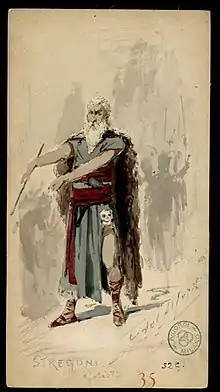Warlock
A warlock is a male practitioner of witchcraft.[1]


Etymology and terminology
The most commonly accepted etymology derives warlock from the Old English wǣrloga, which meant "breaker of oaths" or "deceiver".[2] The term came to apply specially to the devil around 1000.[3] In early modern Scots, the word came to refer to the male equivalent of a "witch" (which can be male or female, but has historically been used predominantly for females).[4][5][6] The term may have become associated in Scotland with male witches due to the idea that they had made pacts with Auld Hornie (the devil) and thus had betrayed the Christian faith and broke their baptismal vows or oaths.[7] From this use, the word passed into Romantic literature and ultimately into 20th-century popular culture. A derivation from the Old Norse varð-lokkur, "caller of spirits", has also been suggested,[8][9][10] but the Oxford English Dictionary considers this implausible due to the extreme rarity of the Norse word and because forms without hard -k, which are consistent with the Old English etymology ("traitor"), are attested earlier than forms with a -k.[11]
History
Although most victims of the witch trials in early modern Scotland were women, some men were executed as warlocks.[12][13][14]
In his day, the Scottish mathematician John Napier (1550-1617) was often perceived as a warlock or magician because his interests in divination and the occult, though his establishment position likely kept him from being prosecuted.[15][16]
References
- "Definition of warlock". English Oxford Living Dictionaries. Oxford University Press. Archived from the original on July 24, 2012. Retrieved 29 December 2018.
- "Warlock". Oxford English Dictionary (2nd ed.). Oxford University Press. 1989. Archived from the original on 2006-06-25. Retrieved 2006-08-30.
- Harper, Douglas. "warlock". Online Etymology Dictionary. Retrieved 11 August 2020.
- McNeill, F. Marian (1957). The Silver Bough: A Four Volume Study of the National and Local Festivals of Scotland. Vol. 1. Glasgow: William Maclellan.
- Chambers, Robert (1861). Domestic Annals of Scotland. Edinburgh: W. & R. Chambers.
- Sinclair, George (1814). Satan's Invisible World Discovered. Edinburgh: James Clarke.
- Howard, Michael (2013). "7". Scottish Witches and Warlocks (1st ed.). Three Hands Press. p. 91.
It is possible that it became associated with wizards and male witches in Scotland in the sense that someone who made a pact with Auld Hornie had betrayed the Christian faith and broken their baptismal vows. In that respect they were considered to be an 'oath breaker', a traitor and an enemy of the Church.
- Cleasby, R.; Vigfusson, G. (1874). An Icelandic-English Dictionary. London: Macmillan.
- Olsen, M. (1916). Maal Og Minne. Oslo: Bymalslaget.
- Loewe, M.; Blacker, C. (1981). Oracles and Divination. London: George Allen & Unwin. p. 130.
'Vardlokkur' […] is related to the Scots dialect word 'warlock', wizard, and the meaning is thought to relate to the power to shut in or enclose"
- "Oxford English Dictionary: The definitive record of the English language". 2006-06-25. Archived from the original on 2006-06-25. Retrieved 2023-08-22.
- Thomas Thomson, A History of the Scottish People from the Earliest Times (1896), page 286: "Where one man suffered as a warlock, ten women at least were executed as witches."
- Robert Chambers, Domestic Annals of Scotland: From the Reformation to the Revolution (1874), page 244
- Journal of Jurisprudence and Scottish Law Magazine (1891), Execution of the Judgment of Death, page 397: "We read (Law's Memor. Pref. lix.) that 'one John Brugh, a notorious warlock (wizard) in the parochin of Fossoquhy, by the space of thirty-six years, was worried at a stake and burned, 1643.'"
- Roger A. Mason, Scots and Britons: Scottish Political Thought and the Union of 1603 (2006, ISBN 0521026202), page 199
- Julian Havil, John Napier: Life, Logarithms, and Legacy (2014, ISBN 1400852188), page 19